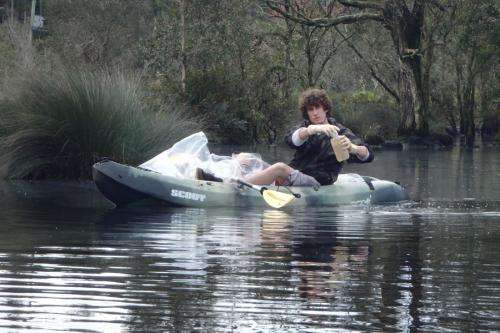Passion for the natural world clears the waters

A toxic legacy has hung over the picturesque northern NSW coastal hamlet of Urunga for almost 40 years. Although now obscured by dense vegetation, the forest of dead melaleuca trees at the edge of a wetland stands as a sad sentinel to a time when environmental protection was in its infancy.
In 1974, the owners of a mineral processing plant – opened in 1969 when prices for trace metals were high – abandoned the site. They left waste tailings containing antimony, arsenic, mercury and lead to leach into the wetland which contains endangered and vulnerable fauna species and feeds the Urunga lagoon.
As a youngster growing up in Urunga, environmental scientist Steven Leahy, now 31, could not have envisaged how this heavily contaminated one-hectare site would shape his career. It yielded a metal of a different sort, this year, when he was awarded a University of Technology, Sydney (UTS) Medal and a First Class Environmental Science Honours degree.
"The site wasn't that well known when I was growing up and local children used to swim in the lagoon. It's actually hidden in plain sight, only 50 metres from a main road but largely inaccessible. It's only when you approach from the lagoon side, as I did when I was taking samples for my honours project, that you see just how denuded of vegetation the area near the dead trees is," Leahy says.
"I remember doing a project about the site when I was at Bellingen High School which must have stayed with me. But although most people recognise the environmental dangers of mercury, lead and arsenic, I don't think they knew what antimony was," he says.
This isn't surprising. Although widely used in products we take for granted, such as flame retardants, brake-pad linings and, increasingly, microelectronics, antimony is a trace metal with no known biological function. A rare resource – 90 per cent of the world's known supply is in China – it is also highly toxic and potentially carcinogenic.
For Leahy, an environmental chemist, expertise gained at CSIRO Land and Water during his industry placement, combined with his formative years in Urunga, resulted in an Honours project that he hoped would both push the boundaries in trace metal analysis and have environmental relevance.
"Despite its toxic potential we know very little about how antimony moves through the environment and current test methods generally aren't sensitive enough to detect the minute background levels found naturally in uncontaminated waters. If you don't know what is there, naturally you can't establish baseline values against which to compare future contamination events," Leahy says.
By combining classical chemical methods with cutting-edge technology at CSIRO, Leahy was able to develop, for the first time, a unique method to quantify dissolved antimony at background concentrations along the length of an uncontaminated Australian estuary. It's an important step towards understanding the bigger picture of how a difficult-to-measure, potentially toxic, contaminant could affect a whole estuary and will enhance environmental monitoring by allowing the differentiation of contaminant and natural antimony sources.
In what has turned out to be exquisite timing a week after the young scientist received his testamur and prestigious award from UTS, the NSW Crown Lands department announced that a remediation plan for the contaminated site in Urunga had been agreed and final approval sought through the NSW Department of Planning. Bellingen Shire Council's general manager Liz Jeremy welcomed the news and was reported in the Nambucca Guardian saying that the remediation would "see the site rendered safe … eventually it will be redeveloped and re-opened for passive recreation".
For Leahy, as a scientist with a passion for protecting the natural environment, there is enormous satisfaction in being able to pull apart a complex problem and get closer to understanding the unknown chemistry of a substance whose environmental impact should not be underestimated.
"I felt that there really was a need to develop a precise and accurate method to detect antimony in estuarine waters. People might say that antimony isn't such a big deal, why bother? However we know demand for resources keeps growing. Australia has under-exploited antimony reserves in the mid-north coast NSW catchments. For development to be sustainable we need to protect the environment for future generations, so investigating and monitoring trace metal contamination is important."
Provided by University of Technology, Sydney



















